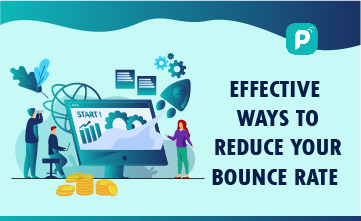Is your website suffering from a high bounce rate? Don’t worry, we’ve got you covered! In this blog, we will share valuable insights and practical tips on how to reduce bounce rate of your website. By implementing these strategies, you can improve user experience, increase engagement, and ultimately drive more conversions. Let’s dive in and optimize your website for success!
What is Bounce Rate?
Bounce rate is known as the percentage of viewers who exit a webpage without carrying out any action. It includes filling in contact details, clicking on any link, or buying any product or service. This rate is calculated by the total number of single-page visits divided by the total entries on the website.
For instance, if the homepage of a website witnesses close to 500 visitors in a single month, and 250 of those leave the page without processing to the other pages, then the bounce rate will be 50%.
Bounce rate is necessary for two main factors:
- The company can increase its conversion rate by directly approaching the viewers. And speaking to them to know they did not make a purchase.
- Bounce rate has the potential to influence Google’s ranking algorithm.
How to Reduce Bounce Rate of Your Website?
Before carrying out activities that will help reduce bounce rate, one should analyze web analytics. It helps to understand where changes are most needed. However, listed below are certain ways in which a company can reduce the high bounce rate of its website:

Content Strategy
If the business wishes to drive its engagement level, one of the most impactful ways is to identify and highlight content. It includes identifying the content that is liked by the viewers and is in demand. Post identification, the business can design its website to make it more engaging.
For instance, the company can explain what it wishes to offer in detail. It can include interactive images that better explain the offerings. If a large portion of your website traffic comes from returning visitors, you can reduce the bounce rate. By keeping the content fresh, you can encourage visitors to stay on your website for longer periods of time.
Analytics
Another effective way of reducing the high bounce rate is to refine how the metric is being evaluated. Analytics software like Google Analytics counts a visitor as one bounce. Even if a user spends a good amount of time on a webpage and engages with its elements, it will still be considered a bounce. To avoid this, it is important to focus on optimizing the conversion rate and encouraging users to complete desired actions.
Studying analytics to identify the various traffic sources of users can prove to be helpful. It can help in studying where the website’s bounce rate needs the most improvement. Users who arrive on a website through an organic search engine query may find the content valuable, resulting in a lower bounce rate and higher conversion rate. This highlights the importance of optimizing websites for search engines to attract targeted organic traffic.
Marketing
Comparing bounce rates on the basis of channels like organic, paid, referral, social media, and direct will help the company see if there are issues. There may be issues with traffic sources, that could otherwise indicate an issue higher up the funnel. If a single channel has a high bounce rate when compared to others, it is worth analyzing the company’s marketing campaigns or efforts for the channel.
For instance, if visitors coming to the site through display are bouncing at a high rate, it is important to ensure that ads are relevant to the website content on the landing page they are being redirected to.
Website design and usability
Along with showcasing the most relevant content, the business must enhance the website design and usability to make it more engaging for visitors. This can also include activities like enhancing the quality of graphics, using good colour contrast and modifying spacing and font size to make texts more readable.
A company’s website must be designed in a way that the users can the information they are looking for in as few clicks as possible. Providing a large search bar along with a clear navigational structure can help boost engagement. Primarily if the company’s website provides a wide range of products or services.
A major usability fix that can considerably reduce the website bounce rate is the total page load time. Reports indicate that users are more likely to navigate away from a page that takes seconds to load.
Wrapping Up
All in all, bounce rate is an integral website metric to track when studying the performance of the website and its numerous web pages. Although it is fine for certain pages to showcase a higher bounce rate when compared to others, a company must consider a marketing funnel.
In case the company notices that visitors are bouncing on the sales page, they must analyze the problem. Fixing technical problems, optimizing the website for mobile, paying attention to user experience, and checking the data will help strategize the best ways to keep clients in the funnel. From there, the company can begin developing customer retention policies once the customers convert.
Do you struggle with a high bounce rate on your website? Get in touch with us, and our experts will assist you!
All images belong to their respective owners. Please email [email protected] if removal is required.




